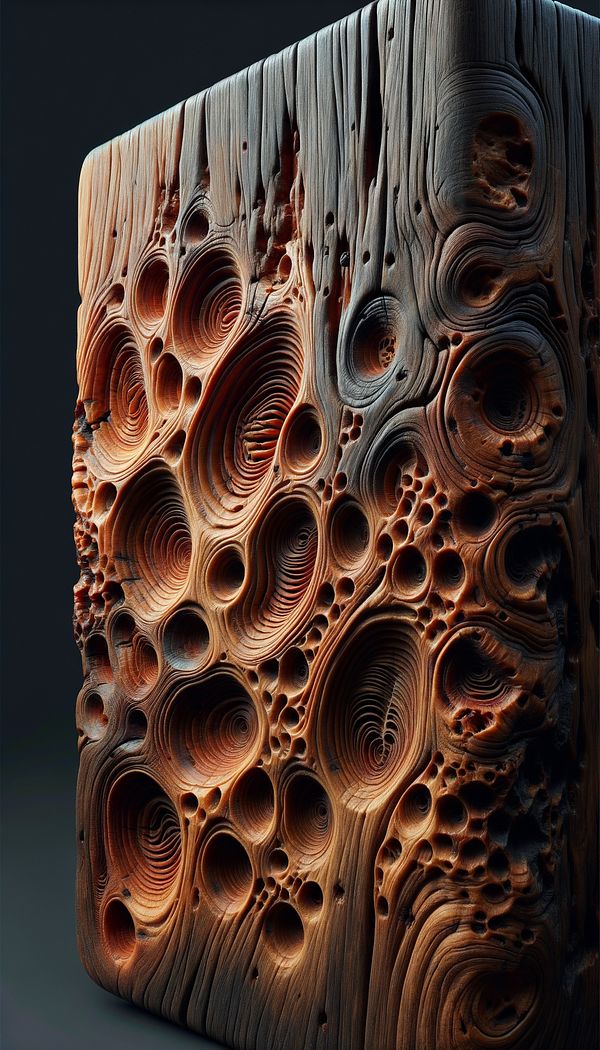What is Worm Holes?
Worm holes are small, round holes created by wood-boring insects, often giving wood a distressed, aged appearance.
Description
Worm holes are a distinctive feature often found in wood and furniture that gives pieces an antique or rustic charm. They are literally tiny holes bored into the wood by insects, specifically beetle larvae. These beetles lay eggs in the crevices of wood; when the larvae hatch, they burrow into the wood, creating the characteristic small, round holes as they feed on the wood fibers.
In interior design, worm holes can be appreciated for the sense of history and character they add to wooden items. While they are a natural occurrence in aging wood, worm holes can also be artificially created in new wood to simulate an antique look. This technique, part of a broader distressing process, can add visual depth and texture to furniture, architectural elements, and decorative objects.
The presence of worm holes does not necessarily indicate a weakness in the material; often, the affected wood has been treated to eradicate the insects and prevent further damage. However, the decision to keep or incorporate worm holes in a design depends on the desired aesthetic and the structural integrity needed for the piece's intended use.
Usage
Worm holes are often sought after in the realms of antique furniture and rustic interior design styles, where they contribute significantly to the aesthetic value of wooden furniture, architectural elements, and decorative objects. Not only do they add a touch of history and authenticity, but they also bring texture and visual depth to the piece, enhancing the overall design. In more modern contexts, artificially created worm holes are used to imbue new pieces with a vintage or distressed look, broadening their appeal across various design preferences.
FAQs
-
How do worm holes form in wood?
Worm holes form when wood-boring insects, particularly beetle larvae, burrow into the wood to feed on its fibers. This creates small, round holes in the wood's surface.
-
Can worm holes be artificially created for aesthetic purposes?
Yes, worm holes can be artificially created in new wood as part of a distressing process to simulate an aged, antique look. This involves using tools to mimic the appearance of natural worm holes.
-
Do worm holes affect the structural integrity of wood?
The presence of worm holes does not necessarily indicate a structural weakness. Often, wood with worm holes has been treated to remove the insects and prevent further damage. However, excessive worm holes may compromise the wood's strength, depending on their size and density.
Practical Application
To incorporate the unique charm of worm holes into interior designs, consider using authentic aged wood with natural worm holes or employing distressing techniques on new wood to artificially create the effect. This can add visual interest and a sense of history to furniture, decorative objects, and architectural elements. When choosing pieces with worm holes, ensure they have been properly treated to prevent insect damage and assess the structural integrity for the piece's intended use.
-
Design Styles478 articles
-
Furniture Types599 articles
-
Decorative Techniques322 articles
-
Materials & Textiles360 articles
-
Colour TemperatureColour temperature is a characteristic of visible light that has important applications in lighting, photography, videography, publishing, manufacturing, astrophysics, horticulture, and art.
-
GothicGothic refers to a style that is characterized by intricate designs, pointed arches, and a heavy emphasis on verticality and light.
-
CushionA soft, padded textile item designed for support or decoration.
-
ElevationElevation is a flat representation of a facade or an interior wall, depicting it head-on.
-
LayeringLayering in interior design is the process of adding multiple elements together to create depth, interest, and balance within a space.
